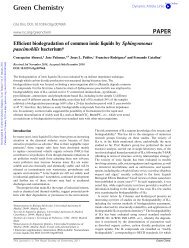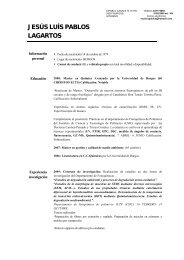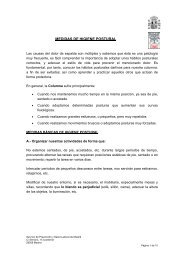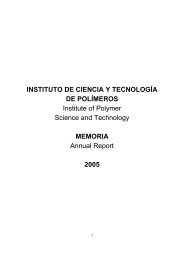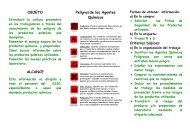Experimental and Theoretical Study of an Improved Activated ...
Experimental and Theoretical Study of an Improved Activated ...
Experimental and Theoretical Study of an Improved Activated ...
You also want an ePaper? Increase the reach of your titles
YUMPU automatically turns print PDFs into web optimized ePapers that Google loves.
8228 Muñozetal. Macromolecules, Vol. 40, No. 23, 2007<br />
Scheme 3. Synthesis <strong>of</strong> Polyimides with CTMS <strong><strong>an</strong>d</strong> Py Table 2. ∆H <strong><strong>an</strong>d</strong> ∆G Values for the Silylation Reaction between<br />
Amines <strong><strong>an</strong>d</strong> CTMS<br />
reaction ∆H (kcal/mol) ∆G (kcal/mol)<br />
<strong>an</strong>iline 15.6 17.1<br />
4-nitro<strong>an</strong>iline 15.2 16.8<br />
2,6-dimethyl<strong>an</strong>iline 20.7 22.4<br />
<strong><strong>an</strong>d</strong> also is able to interact with the trimethylsilyl moiety<br />
enh<strong>an</strong>cing the reaction rate, because the electronic interaction<br />
on the group increases the length <strong>of</strong> the Si-N bonds <strong><strong>an</strong>d</strong> brings<br />
about a higher electronic density on the nitrogen atom, favoring<br />
the electronic tr<strong>an</strong>sfer to the oxygen atoms <strong>of</strong> the <strong>an</strong>hydride<br />
group <strong><strong>an</strong>d</strong> hence helping the opening <strong>of</strong> this moiety, crucial<br />
step in the reaction (tr<strong>an</strong>sition state in Scheme 3).<br />
Since it is not entirely clear if the role <strong>of</strong> Py is merely as <strong>an</strong><br />
HCl acceptor or if it also causes activation <strong>of</strong> the reactive group,<br />
we decided to further investigate the polyimidation reaction<br />
using only Py as activator.<br />
Polymerization with Py. The reactions in the presence <strong>of</strong><br />
pyridine were conducted as described above. Under these<br />
conditions, polyimides with inherent viscosities r<strong>an</strong>ging between<br />
0.16 <strong><strong>an</strong>d</strong> 0.54 dL/g were obtained. These values are lower th<strong>an</strong><br />
those obtained when the reaction proceeded without additives,<br />
<strong><strong>an</strong>d</strong> similar to the obtained values when only CTMS was used.<br />
This result seems to indicate that either a basic or acid media<br />
conduces to depropagation reactions <strong><strong>an</strong>d</strong> therefore yields low<br />
molecular weight polymers. 31<br />
The low molecular weights obtained are <strong>an</strong>omalous because<br />
it is accepted that a base increases the reaction rate between <strong>an</strong><br />
<strong>an</strong>hydride <strong><strong>an</strong>d</strong> <strong>an</strong> amine. However, the results obtained in this<br />
paper clearly show that the polymerization degree is much lower<br />
th<strong>an</strong> that obtained when <strong>an</strong> aprotic polar solvent is used without<br />
<strong>an</strong>y base.<br />
A preliminary theoretical study seems to indicate that the<br />
nitrogen <strong>of</strong> pyridine, because <strong>of</strong> its high electronic density, is<br />
able to interact with the electron-poor aromatic <strong>an</strong>hydride moiety<br />
increasing its electronic density <strong><strong>an</strong>d</strong> consequently lessening its<br />
reactivity. Additional theoretical results <strong><strong>an</strong>d</strong> a more thorough<br />
discussion on this topic will be presented in a future paper. 32<br />
<strong>Theoretical</strong> <strong>Study</strong>. A theoretical study <strong>of</strong> the polyimidation<br />
reaction was also carried out. First, the electronic <strong><strong>an</strong>d</strong> geometric<br />
parameters <strong>of</strong> 6FDA <strong><strong>an</strong>d</strong> the aromatic diamines were calculated<br />
both by semiempirical, AM1, <strong><strong>an</strong>d</strong> DFT, B3LYP/6-31G(d),<br />
methods. Also, <strong><strong>an</strong>d</strong> for simplicity sake, phthalic <strong>an</strong>hydride<br />
(PTA), <strong>an</strong>iline, 4-nitro<strong>an</strong>iline <strong><strong>an</strong>d</strong> 2,6-dimethyl<strong>an</strong>iline were used<br />
as models <strong><strong>an</strong>d</strong> also for the calculation <strong>of</strong> the diverse reaction<br />
pathways <strong>of</strong> the imidation reaction, which have been used to<br />
justify the reactivity <strong>of</strong> these monomers.<br />
Silylation <strong>of</strong> Aromatic Amines. The mech<strong>an</strong>ism <strong>of</strong> amine<br />
silylation has not yet been clearly determined, but it is<br />
experimentally observed that the presence <strong>of</strong> a base is necessary<br />
Table 3. HOMO Energy <strong><strong>an</strong>d</strong> HOMO-LUMO Energy Gap <strong>of</strong> Non<br />
Silylated <strong><strong>an</strong>d</strong> Silylated (in Parenthesis) Diamines<br />
to obtain silylated diamines whether good yields <strong><strong>an</strong>d</strong> high<br />
reaction rates are to be achieved. The presence <strong>of</strong> a tertiary<br />
amine acting as a base is so import<strong>an</strong>t that the stronger is the<br />
base (lower pKa), the faster will be the silylation rate. However,<br />
it is necessary to control the basicity <strong>of</strong> the employed tertiary<br />
amine since if its basicity is very high the diamine c<strong>an</strong> be<br />
disilylated, becoming less reactive toward electrophilic systems<br />
because <strong>of</strong> steric effects. When the silylation is carried out with<br />
no added base, the bases present in the reaction medium are<br />
strictly the own aromatic diamine <strong><strong>an</strong>d</strong> the reaction solvent, <strong><strong>an</strong>d</strong><br />
hence, the reaction rate will depend on the pKa <strong>of</strong> these<br />
compounds. Thus, in the beginning <strong>of</strong> the silylation reaction,<br />
the amine that is not reacting with CTMS will act as a base,<br />
<strong><strong>an</strong>d</strong> hence, the theoretical yield <strong>of</strong> silylation will be 50%.<br />
Afterward, the equilibrium between the protonated diamine, that<br />
acted as base, <strong><strong>an</strong>d</strong> the basic solvent (Scheme 4), even having a<br />
much lower basicity, will permit the system to evolve to a higher<br />
silylation yield.<br />
In a first stage, a study <strong>of</strong> silylation was carried out for <strong>an</strong>iline,<br />
4-nitro<strong>an</strong>iline <strong><strong>an</strong>d</strong> 2,6-dimethyl<strong>an</strong>iline. The study consisted on<br />
calculating the enthalpy <strong><strong>an</strong>d</strong> Gibbs free energy at 298 K by<br />
using the Force keyword in the program Gaussi<strong>an</strong>. The energy<br />
implied in the silylation reaction was determined by me<strong>an</strong>s <strong>of</strong><br />
the following equations:<br />
<strong><strong>an</strong>d</strong><br />
compound EHOMO (eV) ∆Egap (eV)<br />
<strong>an</strong>iline -5.39(-5.20) 2.78(2.59) a<br />
4-nitro<strong>an</strong>iline -6.25(-6.03) 3.64(3.42) a<br />
2,6-dimethyl<strong>an</strong>iline -5.24(-5.34) 2.63(2.73) a<br />
1a -4.86(-4.69) 1.75(1.58)<br />
1b -5.07(-4.89) 1.96(1.78)<br />
1c -5.51(-5.30) 2.40(2.19)<br />
1d -5.67(-5.46) 2.56 (2.35)<br />
1e -4.92(-5.06) 1.81(1.95)<br />
a ∆Egap ) E PTA LUMO - E amine model HOMO, E PTA LUMO )-2.61 eV. ∆Egap<br />
) E 6FDA LUMO - E diamine HOMO, E 6FDA LUMO )-3.11 eV.<br />
Scheme 4. Equilibrium Reactions Involved in the Protonation <strong>of</strong><br />
Amides in the Presence <strong>of</strong> Aprotic Solvents<br />
∆H silylation ) (∆H SiAm + ∆H HCl ) - (∆H Am + ∆H CTMS )<br />
∆G silylation ) (∆G SiAm + ∆G HCl ) - (∆G Am + ∆G CTMS )<br />
<strong><strong>an</strong>d</strong> the results <strong>of</strong> these calculations are shown in Table 2.<br />
Speaking on thermodynamic terms, it could be observed that<br />
the silylation <strong>of</strong> <strong>an</strong>iline <strong><strong>an</strong>d</strong> 4-nitro<strong>an</strong>iline is endoergic in about<br />
17 kcal/mol, with ∆G differences for these two molecules lower<br />
th<strong>an</strong> 0.3 kcal/mol, whereas the silylation <strong>of</strong> 2,6-dimethyl<strong>an</strong>iline<br />
showed a free energy value 4.5 kcal/mol higher th<strong>an</strong> for <strong>an</strong>iline




